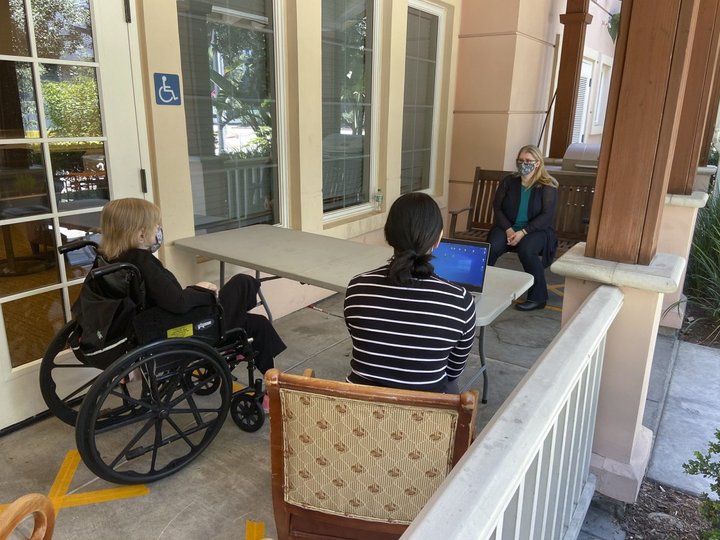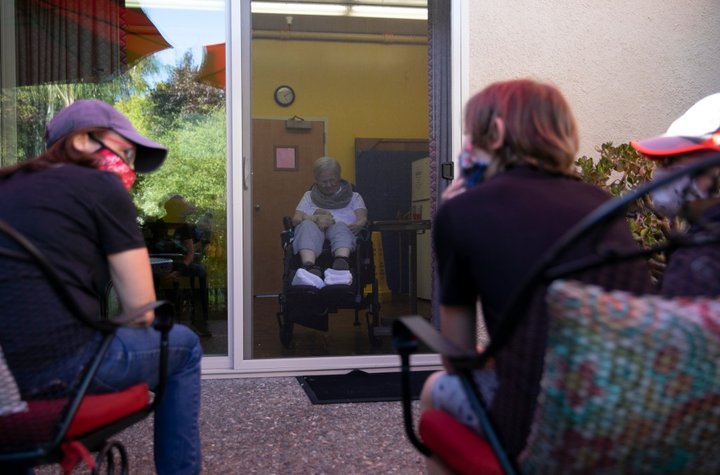
Maitely Weismann, far right, meets outdoors with her mother, Celia O’Regan Weismann, 77, left, on July 13 at a Los Angeles memory care facility for the first time since the pandemic began. Photo courtesy of Maitely Weismann.
###
Maitely Weismann moved her 77-year-old mother from New York into a Los Angeles assisted living facility in mid-March, planning frequent visits to help her settle in. The timing couldn’t have been worse, as California’s pandemic lockdown had just banned virtually all visits in long-term care homes.
Since then, Weismann has mostly seen her mother, who has dementia and minimal use of her arms and legs, only through a window. Recently she was able to set up their first, carefully orchestrated outdoor visit – albeit from a distance, as her mother, wearing a mask and pink slippers, sat in a wheelchair behind a table, accompanied by a chaperone. It did not go well.
“In her mind, she’s locked up without me because she’d done something wrong. I can see she’s deteriorated, her dementia and aphasia have worsened considerably and I can do absolutely nothing to help her,” said Weismann, a former television actress who now runs a Santa Monica talent agency with her husband. “I’ve taken care of her for almost all of my life, and now I cannot be there to support her daily needs in this short-staffed, low-engagement and high-neglect nightmare of a reality we’re all living. The lack of oversight is just as dangerous as COVID itself.”
“At some point keeping older adults isolated will cause considerable harm.”
— Mike Wasserman, California Association of Long Term Care Medicine
As the pandemic drags on, and most of California’s long-term care facilities remain virtually shuttered to visitors, families and nursing home watchdogs are saying that video calls and window visits aren’t enough anymore. And they’re mobilizing in California and nationwide to get state officials to allow in at least one “essential caregiver” to watch over their loved ones, many of whom suffer from dementia.
Weismann has set up a Facebook group, Essential Family Caregivers, to help people organize to push government officials to expand visitation with appropriate precautions. Another Facebook group with more than 6,000 members, Caregivers for Compromise, was set up by a Florida woman who took a job as a dishwasher at a memory care center to be able to see her husband, who has early-onset Alzheimer’s disease; the group now has a California offshoot. That group has drafted a letter to Gov. Gavin Newsom, pleading with him to reopen long-term care homes to essential caregivers designated by the resident.
“Our loved ones are dying of isolation and loneliness, and it has to stop,” according to the letter, which has not been sent yet to the governor. “While we appreciate your efforts to save them from the virus, there comes a point when the effects of isolation are more deadly than the risk of contracting COVID-19.”
The watchdog group California Advocates for Nursing Home Reform has asked the California Department of Public Health “many times” to allow a designated visitor and to enforce the agency’s guidance permitting outdoor visits for family members, said the group’s director, Pat McGinnis. The agency is deferring decisions to local health departments, McGinnis said.
“We have intervened in numerous cases, and, if the relatives push enough, they can seem to get to see the residents,” McGinnis said. “However, like the national picture (there is) no uniform, consistent policy, which is very difficult for residents and their families.”
Family members say they provide important monitoring and care inside the homes, including feeding and bathing residents. The state’s public health agency does allow inside visits but under such stringent conditions – including a decline in cases in the larger community – that few homes can offer them. Even in counties with fewer COVID cases, where visits might be permissible, some facilities won’t allow them, citing liability concerns, advocates say.

Caroline Harrison, left, Jackson Harrison Shirk, 11, right, and his mother, Virginia Harrison, far right, visit with Jackson’s grandmother, Debbie, center, at The Chaparral House, the Berkeley skilled nursing facility where Debbie has lived for the past three years. Debbie, who family members refer to as mama bear, suffers from dementia and is largely unresponsive during her family’s near-daily socially distant visits. “She doesn’t talk about it but she knows we’re here,” said Jackson. Photo by Anne Wernikoff for CalMatters
To date, California has not allowed family members inside long-term care facilities during the pandemic except at the very end of life, but other states are starting to do so. Minnesota now allows nursing homes and assisted living facilities to admit essential caregivers for up to three hours daily, as long as they wear protective gear including eye protection and a face mask, although the homes are not required to do so. Indiana has a similar policy but requires caregivers to test negative for COVID-19 before entering the building.
Dr. Mike Wasserman, a nursing home medical director and president of the California Association of Long Term Care Medicine, said he supports the idea of designated essential caregivers.
“That needs to happen as soon as possible. At some point keeping older adults isolated will cause considerable harm,” Wasserman said. “I think it is critical that families and the ombudsmen need to be able to go in the facilities and lay eyes on the residents.”
Long-term care ombudsmen, primarily supported by federal money, investigate complaints and monitor the safety and well-being of residents in nursing homes and assisted living facilities.
California’s current visitation guidelines for long-term facilities are written in such a way that “most nursing homes won’t be able to let anyone in for the next two years,” Wasserman said. “We’re going to have to find a better way.”
An industry group for nursing homes remains cautious. “The idea is a good one in concept but may be hard to implement due to the need for increased staff to train residents to don and doff (protective gear), provide testing to visitors, monitor visits and enforce safety rules,” said Deborah Pacyna, spokesperson for the California Association of Health Facilities.
K.J. Page, administrator for the Chaparral House skilled nursing facility in Berkeley, said she would welcome being able to allow family members back into the home with precautions, especially since virtual and window visits have proven distressing for some residents with dementia. Since the pandemic started, the home has had one patient and one food service worker test positive for COVID-19 but currently has no cases, Page said.
“It would actually help us to have families be part of the care, instead of calling us every 20 minutes” to see how their loved one is doing, Page said. Some family members are so anxious that she has designated managers to call them regularly with updates.
Leza Coleman, executive director of the California Long-Term Care Ombudsman Association, said she is concerned that family visiting restrictions are moving from being a short-term fix to a long-term strategy.
She’s already hearing about significant negative impacts for many residents. In addition to loneliness and anxiety, she said, many residents are experiencing weight loss and cognitive decline. Residents who used to walk to the dining room for meals every day are now confined to their rooms, she said, causing her to worry that they won’t be able to walk at all by the time congregate meals resume.
“I don’t understand why they can’t hold a hand if it’s in a glove with a face mask and gown.”
— Leza Coleman, California Long-Term Care Ombudsman Association
Some families will opt to keep loved ones out of long-term care facilities if they believe they won’t be able to see them again, Coleman said. As a result, she said she expects there will be an increase in adult abuse and self-neglect cases as vulnerable people stay home without appropriate care.
Recent state guidance has allowed more families to see their loved ones either at window visits or outside, Coleman said. But some residents – especially those with cognitive impairment – suffer if they’re not able to touch someone they love, she said.
“I don’t understand why they can’t hold a hand if it’s in a glove with a face mask and gown,” Coleman said. “I’m not asking us to be reckless, I’m asking us to examine risk tolerance.”
This is the case for Nancy Klein, 78, whose 52-year-old son is in a Riverside County facility. A massive brain hemorrhage four and a half years ago left him unable to move or speak for himself, except through sighs that Klein interprets as showing relief or frustration or disgust.
Before the pandemic, she said, “I was his only voice, his support person, his caregiver.”
Klein massaged his head and neck every day, in addition to helping with exercise and suctioning out his tracheostomy.
Distanced visits won’t work for her son, Klein said: “He relies on the nurturing and touching.”
Carole Herman, who runs the Sacramento-based Foundation Aiding the Elderly, said she’s been overwhelmed with calls from families asking for help filing complaints about malnutrition, bedsores, sepsis, a broken nose and a blocked catheter, among others. She said she doesn’t know of any family members who have been able to get in to see their loved ones since March, and those who ask too many questions face retaliation or removal of the resident.
“It’s craziness out there, so many people are being harmed, and not just from the virus,” she said. “What’s happening is side effects of the virus.”
###
CALmatters.org is a nonprofit, nonpartisan media venture explaining California policies and politics.
CLICK TO MANAGE